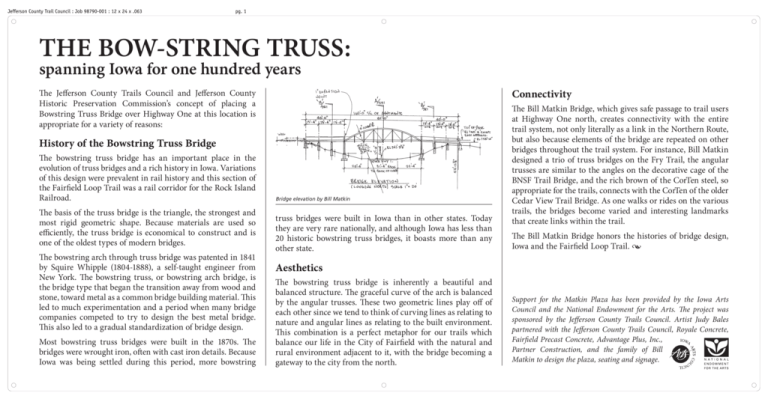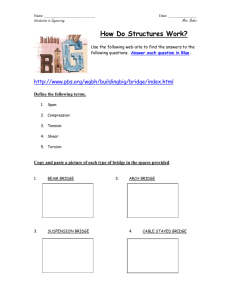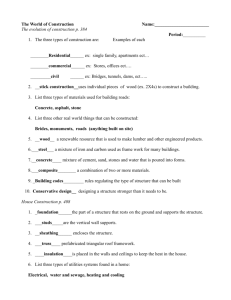THE BOW-STRING TRUSS: - Jefferson County Trails
advertisement

Jefferson County Trail Council : Job 98790-001 : 12 x 24 x .063 pg. 1 THE BOW-STRING TRUSS: spanning Iowa for one hundred years Connectivity The Jefferson County Trails Council and Jefferson County Historic Preservation Commission’s concept of placing a Bowstring Truss Bridge over Highway One at this location is appropriate for a variety of reasons: History of the Bowstring Truss Bridge The bowstring truss bridge has an important place in the evolution of truss bridges and a rich history in Iowa. Variations of this design were prevalent in rail history and this section of the Fairfield Loop Trail was a rail corridor for the Rock Island Railroad. The basis of the truss bridge is the triangle, the strongest and most rigid geometric shape. Because materials are used so efficiently, the truss bridge is economical to construct and is one of the oldest types of modern bridges. The bowstring arch through truss bridge was patented in 1841 by Squire Whipple (1804-1888), a self-taught engineer from New York. The bowstring truss, or bowstring arch bridge, is the bridge type that began the transition away from wood and stone, toward metal as a common bridge building material. This led to much experimentation and a period when many bridge companies competed to try to design the best metal bridge. This also led to a gradual standardization of bridge design. Most bowstring truss bridges were built in the 1870s. The bridges were wrought iron, often with cast iron details. Because Iowa was being settled during this period, more bowstring Bridge elevation by Bill Matkin truss bridges were built in Iowa than in other states. Today they are very rare nationally, and although Iowa has less than 20 historic bowstring truss bridges, it boasts more than any other state. The Bill Matkin Bridge, which gives safe passage to trail users at Highway One north, creates connectivity with the entire trail system, not only literally as a link in the Northern Route, but also because elements of the bridge are repeated on other bridges throughout the trail system. For instance, Bill Matkin designed a trio of truss bridges on the Fry Trail, the angular trusses are similar to the angles on the decorative cage of the BNSF Trail Bridge, and the rich brown of the CorTen steel, so appropriate for the trails, connects with the CorTen of the older Cedar View Trail Bridge. As one walks or rides on the various trails, the bridges become varied and interesting landmarks that create links within the trail. The Bill Matkin Bridge honors the histories of bridge design, Iowa and the Fairfield Loop Trail. Aesthetics The bowstring truss bridge is inherently a beautiful and balanced structure. The graceful curve of the arch is balanced by the angular trusses. These two geometric lines play off of each other since we tend to think of curving lines as relating to nature and angular lines as relating to the built environment. This combination is a perfect metaphor for our trails which balance our life in the City of Fairfield with the natural and rural environment adjacent to it, with the bridge becoming a gateway to the city from the north. Support for the Matkin Plaza has been provided by the Iowa Arts Council and the National Endowment for the Arts. The project was sponsored by the Jefferson County Trails Council. Artist Judy Bales partnered with the Jefferson County Trails Council, Royale Concrete, Fairfield Precast Concrete, Advantage Plus, Inc., Partner Construction, and the family of Bill Matkin to design the plaza, seating and signage. Jefferson County Trail Council : Job 98790-002 : 12 x 8 x .063 pg. 2 Major Donors to the Matkin Bridge Project Warren & Harriet Berman Boggs Electrical Jonathan & Debbie Cutler Great Places & Iowa Arts Council- State of Iowa The Hougher Family LISCO Corporation Ken & Jessica Malloy Family The Rudney Family Schaus Vorhies Manufacturing Schaus Vorhies Contracting Eric & MarySue Schwartz Paul and Carmen Siemsen Brian Stains WD (Doug) Stewart- Canada Anonymous Donors





